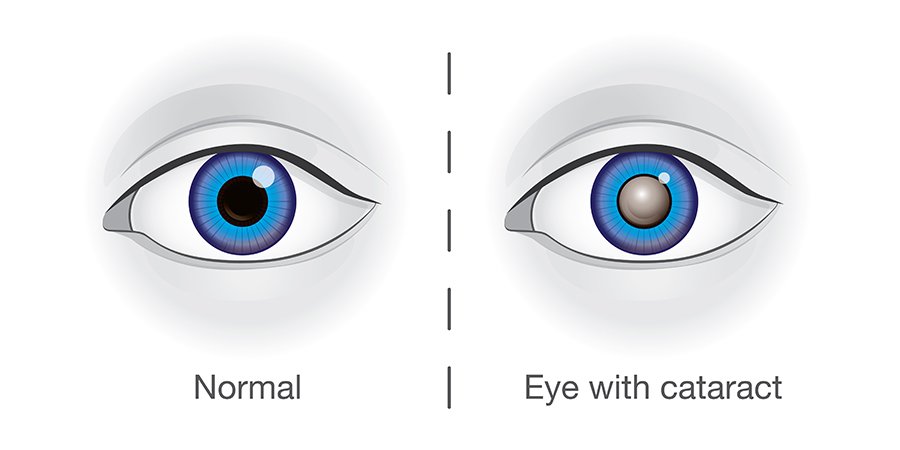Definition of Cataract- This course is designed to understand the concept of community health nursing: nurses’ roles and interventions in family health, school health, occupational health, environmental health, elderly health care, gender issues, disaster management and principles and terminology of epidemiology. The aim of the course is to acquire knowledge and skills in community health nursing.
Definition of Cataract
Any opacification of the crystalline lens or its capsule causing visual impairment is called cataract.

A cataract is a clouding of the lens in the eye which leads to a decrease in vision. Cataracts often develop slowly and can affect one or both eyes. Symptoms may include faded colors, blurry or double vision, halos around light, trouble with bright lights, and trouble seeing at night.
Or,
Cataract is a clouding or loss of transparency of the lens in the eye as a result of tissue breakdown and protein clumping.
Classification of Cataract:
Aetiolocical classification/causes of cataract:
➤ Congenital or developmental cataract: Causes are the followings
- Mostly unknown.
- Hereditary.
- Chromosomal abnormalities, e.g. Down’s syndrome.
- Maternal malnutrition, e.g. Vitamin-D deficiency & hypocalcaemia.
- Maternal infections, as in rubella.
- Foetal hypoxia owing to placental haemorrhage.
- Drug intake during pregnancy e.g. corticosteroids.
➤ Acquired cataract:
- Senile cataract.
- Traumatic cataract.
✔ Mechanical,
✔ Irradiation.
✔ Electric shock.
- Complicated cataract: (due to some other ocular disease).
✔ Anterior uveitis,
✔ High myopia.
✔ Retinal detachment,
✔ Retinitis pigmentosa.
✔ Glaukom flecken.
- Secondary cataract: (due to some systemic disease)
✔ Diabetes mellitus
✔ Hypocalcaemia
✔ Myotonic dystrophy
✔ Atopic dermatitis.
- Toxic cataract: (due to drugs)
✔ Corticosteroids
✔ Chlorpromazine
✔ Long acting miotics.
✔ Busulphan
✔ Amiodarone
✔ Gold.
- Syndromes associated with cataract:
✔ Down’s syndrome
✔ Lowe’s syndrome
✔ Wilson’s disease.
- After-cataract.
(Ref by-SK Basak/5th/239)
➤ According to age of onset:
- Congenital.
- Infantile.
- Juvenile.
- Adult.
- Senile.
➤ According to degree of opacity/according to stage:
- Immature cataract: Transparent lens fibres are present,
- Mature cataract: Entire lens becomes opaque.
- Hypermature cataract: Liquefaction of the opaque lens occurs.
- After cataract: Capsular remains after lens have been removed.

Drugs Causing Cataract:
- Corticosteroids.
- Chlorpromazine.
- Long acting miotics.
- Busulphan.
- Amiodarone.
- Gold.
Risk Factors For Cataract:
- Increasing age.
- Sunlight (especially the UV-A, UV-B components).
- Severe diarrhoeal dehydration.
- Vitamin A, C, E deficiency.
- Diabetes.
- Smoking.
- Corticosteroids.
- Genetic.
Complications Of Cataract:
- Impairment of vision.
- Blindness.
- Lens induced glaucoma (in rare cases)
Cause of Reduced Vision in Cataract:
Vision is reduced in cataract due to opacity of human crystalline lens, so that light cannot reach the retina properly.

Management of Congenital/Developmental Cataract:
Diagnosis:
- Symptoms:
- Mostly asymptomatic.
- White spot or multiple tiny-blue spots over the lens.
- Blurring of vision in bright light.
- Bilateral in 2/3d cases.
Signs:
- Visual acuity is reduced.
- Presence or absence of accommodation reflex.
- Central cataract with good vision.
- Zonular cataract or other large cataract with marked visual impairment.
Laboratory Investigations:
- TORCH test – For Toxoplasma (To), Rubella (R), Cytomegalovirus (C) and Herpes virus (H).
- Test for galactosaemia – Reducing substance in urine.
- Test for Lewe’s syndrome – Urine chromatography for amino acids.
- Test for hypoglycaemia – Blood glucose level.
- Test for hypocalcaemia – Serum calcium, phosphate & X-ray skull.
Treatment:
- Operation is done before 6 months of age.
- Anterior capsulectomy with irrigation and aspiration of cortical matter followed by contact lens or aphakic glasses.
- Phaco-emulsification with irrigation and aspiration.
- If total cataract-removal of lens.
- Other cataract with no symptom- no treatment, but follow up.
Ideal Time of Surgery:
➤ The critical period for development of fixation reflex is between 6 weeks & 6 months of age. So, the best time of surgery is before 6 months of age, to prevent stimulus-deprivation amblyopia.
➤ In dense mono-ocular cataract, the surgery should be done as early as possible, may be on the next day after birth.
Read more:
